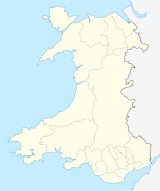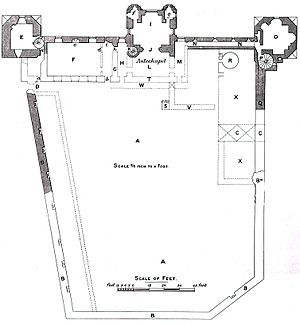Newport Castle facts for kids
Quick facts for kids Newport Castle |
|
|---|---|
| Newport, Wales | |
 |
|
| Coordinates | 51°35′26″N 2°59′42″W / 51.5906°N 2.9950°W |
| Type | Castle |
| Site information | |
| Condition | Ruins |
| Site history | |
| Built | 14th century |
| Battles/wars | Sacked by Owain Glyndŵr |
|
Listed Building – Grade II*
|
|
| Official name: Newport Castle | |
| Designated: | 26 July 1951 |
| Reference #: | 2997 |
Newport Castle (called Castell Casnewydd in Welsh) is a very old ruined castle in Newport, Wales. It was built a long time ago in the 1300s. People think Hugh de Audley, 1st Earl of Gloucester or his son-in-law, Ralph, Earl of Stafford, built it. Its main job was to control who crossed the River Usk.
The castle was also used as an office to collect money and fees from people living nearby. Sometimes, important people lived there, and soldiers stayed there too. In 1402, a Welsh leader named Owain Glyndŵr attacked and damaged it. By 1522, the castle was already falling apart. Later, during the English Civil War, Oliver Cromwell's army took it over. Over the years, it was used less and less. Since 1951, it has been a special Grade II* Listed building, which means it's an important historical site.
Contents
Where is Newport Castle?
You can find Newport Castle in the city of Newport. It sits right next to the River Usk on its west bank. The castle is between the modern Newport Bridge and the nearby railway bridge. It's also close to a main road interchange.
What Did Newport Castle Look Like?
The castle was built using strong Old Red Sandstone and local grey limestone. When it was new, a moat (a deep ditch filled with water) surrounded it. It also had a rectangular outer wall. Experts say that in its best days, the castle would have looked very grand over the town and river.
It had three tall towers. There was a large rectangular tower in the middle and two smaller, roundish towers at each end. Strong walls connected these towers. The castle's shape followed the curve of the riverbank.
One special part was a room above a watergate. This was a fortified gate that allowed people and supplies to arrive by boat. Above this watergate were smaller towers called turrets. Inside, the castle had a great hall, a kitchen, and many rooms. Later, fancy apartments were added, especially for the lord in the south tower. The T-shaped room in the central tower was likely a very important place for ceremonies.
Old maps from 1750 show images of the castle. A detailed drawing of its layout was published in 1885. Over time, new buildings like a railway and roads changed the area around the castle. Most of its inner courtyard and the moat were removed. Today, only the east side of the castle still stands.
A Look Back: The Castle's Story
The First Castle in Newport
The very first castle in Newport was called "New Castle on the River Usk." It was a Norman "motte" castle, which means it was built on a raised earth mound. William Rufus might have built it around 1075. We don't know its exact spot, but many think it was near St Woolos Church.
The first mention of a castle in Newport was in 1126. In 1171, William, Earl of Gloucester, had soldiers there. But the next year, a leader named Iorwerth destroyed it. King Henry II visited in 1172. Records show money was spent on repairs in 1185.
Henry III rebuilt the castle in 1249. Later, Prince Edward took it over in 1265. When he became king in 1295, he ordered more improvements. In 1320, it went to Hugh le Despenser, 1st Earl of Winchester. Two years later, Roger Mortimer, 1st Earl of March attacked it, took its furniture, and set it on fire. It took a lot of wood to rebuild it. The small remains of this first castle were probably buried when a railway tunnel was dug in 1846.
Building the Second Castle (1300s and 1400s)
The Newport Castle we see today was built in the 1300s. It was likely built by Hugh de Audley, 1st Earl of Gloucester, or more probably by his son-in-law, Ralph Stafford, 1st Earl of Stafford. Historians think it was built between 1327 and 1386. A coin from Edward III's time (1327-1377) was found there in 1845.
This new castle had a great view over the river. It helped control river crossings and trade. Newport became a very important place at this time. The castle was first officially written about in 1405. This was after it was repaired from being attacked by Owain Glyndŵr in 1402. Around 1435, Humphrey Stafford did more work on it. Owen Tudor was even held prisoner there in 1460. The castle was mostly used for managing the local area and collecting rent, not often as a home for the lord.
From the 1500s to the 1800s
In the early 1500s, King Henry VIII's uncle, Jasper Tudor, lived in the castle. King Henry VIII took it in 1521. It then belonged to the king until 1547, when Edward VI took over. By 1522, the castle was already in bad shape because it wasn't being looked after.
In 1645, during the English Civil War, Colonel Henry Herbert put 50 soldiers in the castle. But Oliver Cromwell's army captured it in 1648. The Herbert and Morgan families owned the castle for about 300 years, starting in 1548. By 1743, it was mostly a ruin.
In the 1800s, parts of the ruined castle were used as a tannery (where leather is made). Later, it became a brewery. A fire destroyed the brewery in 1883. In 1891, the south tower became owned by the local council. The rest of the castle was bought by Lord Tredegar in 1899. Between 1930 and 1950, the government helped look after the castle and repaired its stonework.
Modern Times (1900s and 2000s)
Today, only the east side of Newport Castle remains. It has been a special Grade II* Listed building since 1951. A new road was built next to the castle in 1970. For safety reasons, the castle ruins were fenced off in 2003. A public path nearby was closed in 2006. The castle has been completely closed since 2011 because of safety worries.
Images for kids
-
Newport Castle by J. M. W. Turner, painted around 1796.
See also
- Grade II* listed buildings in Newport
- List of Scheduled Monuments in Newport






